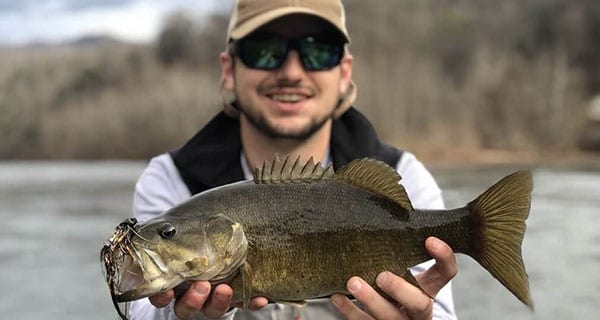Spring has finally arrived, and all that I have thought about over the last month is smallmouth. These fish are native, wild, and untamed in their nature and will challenge anglers of all skill types regardless of whether you target them with the fly rod or with a spinning rod. Regardless of your tactic, there’s one critical component to smallmouth that has to be understood, and that’s where and when to target them. As I’m writing this in April, I’m starting to see smallmouth already on beds which means by May the majority will have come off of their spawning holes in the period bass anglers call the “post spawn.” These fish are lean, hungry, and ready to feed aggressively. Understanding where in a river to target them will greatly help in your understanding of their behaviour and help to appreciate this special species we’re fortunate enough to have in the Southern Appalachians.
Many of my clients who start out fishing for smallmouth look at the river from a “trout” perspective rather than from a bass fishing perspective. This perception isn’t totally incorrect, because smallmouth also relate themselves to the current in a similar fashion to that of trout. Both species will use current breaks in the form of pockets behind rocks, underwater boulders/ logs, and deeper parts of a run to escape from the current. However, one critical difference is how bass relate themselves to these different types of “structure” in a river. Smallmouth are primarily predatory fish once they get around 8-10” long, which is the point at which they start to reorient their diet from small aquatic insects to primarily baitfish and crayfish. So we have to alter our mindset to understand where smallmouth live from an ambush perspective.
When we look at a river with the ambush perspective in mind, then we can start to dissect runs and pockets more effectively. I’ve seen smallmouth orient themselves behind shelves and rocks facing both upstream AND downstream, waiting to ambush prey as it goes by. Deep pockets that transition to surrounding shallower runs can be very deadly this time of year. In the Spring, smallmouth will begin transitioning from deeper runs where they’ve wintered into faster moving pockets and slightly shallower runs where more food opportunities are present. By the time this article is published, most of our smallmouth will be orienting themselves into these areas as the post-spawn bite starts to pick up. This generally starts to happen as the water temperature moves above 52- 58 degrees, which can be variable from river to river. April to May is generally when this temperature change occurs. As that transition occurs, I also start looking towards the banks of the river for new patches of grass, laydowns, and transitions from deep water to shallow water, as stated. Again, the key is to find these locations adjacent to deeper runs and pockets. I normally tell my clients to “look for the spot where the green-blue water meets the sand colored water.” What they’re looking at is that deep-shallow transition.
The main reason that smallmouth start this transition from deep wintering holes to transitional spots is simple: they’re following the bait. Crayfish and baitfish are both starting to move into the same shallower habitat as previously mentioned, and smallmouth will follow suit. Focus your presentations on these transitional zones, especially as the sun starts coming over the river and warms the water temperature up even just by 1-2 degrees. You’d be amazed at how food sources and fish will respond to that slight change in temperature.
Ethan Hollifield is an Environmental/Physical Science Teacher and is also a guide for Southern Appalachian Anglers.
